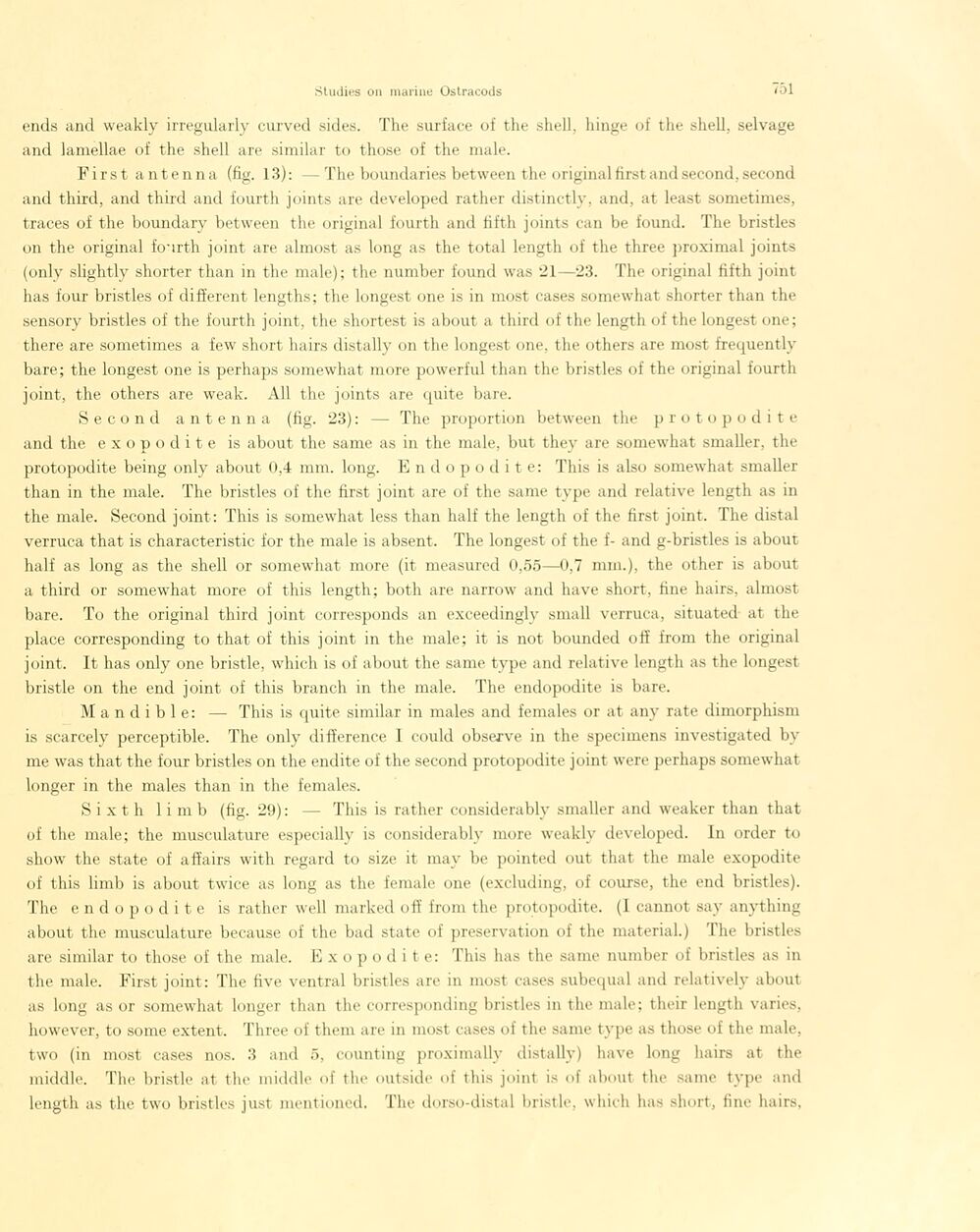
Full resolution (JPEG) - On this page / på denna sida - Sidor ...

<< prev. page << föreg. sida << >> nästa sida >> next page >>
Below is the raw OCR text
from the above scanned image.
Do you see an error? Proofread the page now!
Här nedan syns maskintolkade texten från faksimilbilden ovan.
Ser du något fel? Korrekturläs sidan nu!
This page has never been proofread. / Denna sida har aldrig korrekturlästs.
ends and weakly irregularly cui’ved sides. The surface of the shell, hinge of the shell, selvage
and lamellae of the shell are similar to those of the male.
First antenna (fig. 13): —The boundaries between the original first and second, second
and third, and third and fourth joints are developed rather distinctly, and, at least sometimes,
traces of the boundary between the original fourth and fifth joints can be found. The bristles
on the original fourth joint are almost as long as the total length of the three proximal joints
(only slightly shorter than in the male); the number found was 21—23. The original fifth joint
has four bristles of different lengths; the longest one is in most cases somewhat shorter than the
sensory bristles of the fourth joint, the shortest is about a third of the length of the longest one;
there are sometimes a few short hairs distally on the longest one, the others are most frequently
bare; the longest one is perhaps somewhat more powerful than the bristles of the original fourth
joint, the others are weak. Ail the joints are quite bare.
Second antenna (fig. 23): — The proportion between the protopodite
and the exop odite is about the same as in the male, but they are somewhat smaller, the
protopodite being only about 0,4 mm. long. Endopodite: This is also somewhat smaller
than in the male. The bristles of the first joint are of the same type and relative length as in
the male. Second joint: This is somewhat less than half the length of the first joint. The distal
verruca that is characteristic for the male is absent. The longest of the f- and g-bristles is about
half as long as the shell or somewhat more (it measured 0,55—0,7 mm.), the other is about
a third or somewhat more of this length; both are narrow and have short, fine hairs, almost
bare. To the original third joint corresponds an exceedingly small verruca, situated at the
place corresponding to that of this joint in the male; it is not bounded off from the original
joint. It has only one bristle, which is of about the same type and relative length as the longest
bristle on the end joint of this branch in the male. The endopodite is bare.
Mandible: — This is quite similar in males and females or at any rate dimorphism
is scarcely perceptible. The only difference I could observe in the specimens investigated by
me was that the four bristles on the endite of the second protopodite joint were perhaps somewhat
longer in the males than in the females.
S i X t h 1 i m b (fig. 29): — This is rather considerably smaller and weaker than that
of the male; the musculature especially is considerably more weakly developed. In order to
show the state of a ff airs with regard to size it may be pointed out that the male exopodite
of this limb is about twice as long as the female one (excluding, of course, the end bristles).
The endopodite is rather well marked off from the protopodite. (I cannot say anything
about the musculature because of the bad state of préservation of the material.) The bristles
are similar to those of the male. Exopodite: This has the same number of bristles as in
the male. First joint: The five ventral bristles are in most cases subequal and relatively about
as long as or somewhat longer than the corresponding bristles in the male; tlieir length varies,
however, to some extent. Three of them are in most cases of the same type as those of the male,
two (in most cases nos. 3 and 5, counting proximallv distally) have long liairs at the
middle. The bristle at the middle of the outside of this joint is of about the same type and
length as the two bristles just mentioned. The dorso-distal bristle, which has short, fine hairs,
<< prev. page << föreg. sida << >> nästa sida >> next page >>